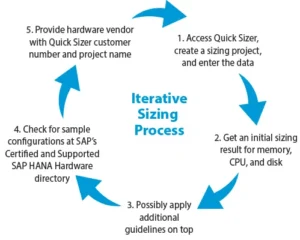HANA is an integral part of SAP. From the very beginning, the strategy has been to offer real-time updates to explore the untapped business potential. Today, businesses use SAP S/4HANA to solve a variety of business problems using exceptional platform capabilities. Implementing HANA into your SAP environment will help you to build an in-memory database that is modern and fast.
But before we understand what infrastructure is required, it becomes essential to know what SAP HANA is, and what it can do for your business process.
SAP HANA is a strategic platform that provides real-time problem solving and big data analysis using a new generation of applications. New possibilities are opened that provides in-depth market and business process analysis using real-time updates, multi-dimensional analysis, and multi-level calculative evaluations. Your business might be in an urgency to implement SAP HANA because, with the growth in the size of business, grows the amount of data that is stored and analyzed every single day. The workloads are ever-increasing and performance is not a privilege, but a necessity. To overcome the performance of traditional databases, data architectures have moved to more complex data structures.
S/4 HANA – the next generation of SAP Business Suite, enables the users to bring together the power of big-data analysis, and transactions on a single platform, with the help of highly reduced data structure that is well-optimized for your business requirements. Simplified data-structures, removal of aggregates and better optimization of objects and code, makes it an ideal candidate for business transformation using databases. Plus, when users decided upon the migration, an intermediatory tool is known as Suite on HANA is readily available for migrating from databases like Oracle to HANA.
Moreover, HANA has all the settings ready to be incorporated as an in-memory database system that not only provides high speed but also extraordinary analytical performance. In addition to this, modeling and data integration helps in making sure that it remains the core component for accessing data, which also includes unstructured data. Cases like predictive analysis, maintenance and analyzing frauds become easier through a high-speed process of data.
However, to achieve these functions of SAP HANA, one needs to know that infrastructure is essential, and what factors need to be checked. It is mandatory to know that SAP benefits can be validated, provided you have infrastructure that does not limit its use. A huge amount of quality functioning infrastructure is required to transfer data from disks to server RAM.
- Scalability – to optimize the growth and forward thinking of any business, scalability becomes an important factor. HANA, when implemented, is limited in the beginning, but has an ability to scale up rapidly. As per statistics and data, short to medium term capacity turns out to be a lot greater than the capacity in the beginning. It can easily handle the natural growth of structured data, which is about 20% yearly. The benefit of scalability of HANA is that it can take in all the data on the platform itself, instead of limiting itself, like other platforms, that lack scalability. The lack of scalability requires the company to implement fragmented developments or increasingly complex IT setups. It is very important that your plan is scalable in the long run.
- Resilience – Resilience provides your data with long term performance. It is important that the data isn’t volatile. In fact, it is important because some modules which are in-memory can slow down the system. With the help of the right infrastructure, one can make a huge difference in HANA environments.
- Flexibility – There are two types of SAP HANA platforms: Appliances and TDI (Tailored Datacenter Integration). There is preintegration of hardware and software, which is completely managed, and a dedicated environment that is predictable.
Particularly, it is very critical to make sure that the size of the hardware is correct on which the SAP HANA runs, which can otherwise lead to poor performance and decreased response times. One of the very useful tools is the SAP Quick Sizer tool, provided by SAP since 1996. Also, the accuracy of the sizing depends on Accurate data. Similar to the classic version of Quick Sizer, the current version for SAP HANA uses parameters like peak performance, average load, and other similar points to determine the key performance indicators which are the memory, CPU, and disk space. These factors are based on information from the usage statistics to help deploy the application, which includes business processes, user numbers and data retention times.
A process known as Iterative Sizing is used to accurately measure the system requirements. As per SAPinsider, a popular website has described the five-step process for ITERATIVE SIZING.
STEP #1 – The first step is to access quick sizer, and create a sizing project wherein you can enter the required data as per your business process. The data is real, but the primary assessment is only temporary and you need to follow the rest of the four steps in the sizing process to completely asses the infrastructure requirements.
STEP #2 – In the second step, you will receive initial sizing results for different computing components like memory, CPU and disk space. This will help you to determine your requirement better, and help you in financing and budgeting the process into your accounts. Moreover, it will also help you to determine how much weight the implementation of SAP HANA will bring to your balance sheet.
STEP #3 – But these measurements are not enough. There are a number of guidelines that you need to follow to move forward in step three. Make sure you have an expert SAP consultant by your side to help you determine the additional guidelines before setting up the final assessment of your infrastructure requirement.
STEP #4 – Once you are done with the required guidelines, make sure that you check the sample configurations that are provided with the SAPs certified and supported SAP HANA hardware directory. This step will help you determine if you already have enough budget to go through the process and place an order with the specialist.
STEP #5 – Doing it all on your own may give you faulty requirements. Hire a certified consultant, like Accely, to help you with your SAP S/4 HANA implementation to get it done quickly and easily. With this implementation, you will be able to provide a hardware vendor, with Quick Sizer customer number and project name.
Conclusion
Moreover, once you are through the process, using the Sizing Tool, you are good to go. However, there is more to the process than just figuring out the infrastructure requirements. Hiring an SAP consultant can do much more than just give you a quotation for your requirements. We provide an in-depth assessment of your SAP infrastructure sizing requirements and help you successfully implement SAP HANA into your process.






